Jun Yu
Lehigh University
CoMo: Compositional Motion Customization for Text-to-Video Generation
Oct 27, 2025Abstract:While recent text-to-video models excel at generating diverse scenes, they struggle with precise motion control, particularly for complex, multi-subject motions. Although methods for single-motion customization have been developed to address this gap, they fail in compositional scenarios due to two primary challenges: motion-appearance entanglement and ineffective multi-motion blending. This paper introduces CoMo, a novel framework for $\textbf{compositional motion customization}$ in text-to-video generation, enabling the synthesis of multiple, distinct motions within a single video. CoMo addresses these issues through a two-phase approach. First, in the single-motion learning phase, a static-dynamic decoupled tuning paradigm disentangles motion from appearance to learn a motion-specific module. Second, in the multi-motion composition phase, a plug-and-play divide-and-merge strategy composes these learned motions without additional training by spatially isolating their influence during the denoising process. To facilitate research in this new domain, we also introduce a new benchmark and a novel evaluation metric designed to assess multi-motion fidelity and blending. Extensive experiments demonstrate that CoMo achieves state-of-the-art performance, significantly advancing the capabilities of controllable video generation. Our project page is at https://como6.github.io/.
From Pixels to Views: Learning Angular-Aware and Physics-Consistent Representations for Light Field Microscopy
Oct 26, 2025Abstract:Light field microscopy (LFM) has become an emerging tool in neuroscience for large-scale neural imaging in vivo, notable for its single-exposure volumetric imaging, broad field of view, and high temporal resolution. However, learning-based 3D reconstruction in XLFM remains underdeveloped due to two core challenges: the absence of standardized datasets and the lack of methods that can efficiently model its angular-spatial structure while remaining physically grounded. We address these challenges by introducing three key contributions. First, we construct the XLFM-Zebrafish benchmark, a large-scale dataset and evaluation suite for XLFM reconstruction. Second, we propose Masked View Modeling for Light Fields (MVN-LF), a self-supervised task that learns angular priors by predicting occluded views, improving data efficiency. Third, we formulate the Optical Rendering Consistency Loss (ORC Loss), a differentiable rendering constraint that enforces alignment between predicted volumes and their PSF-based forward projections. On the XLFM-Zebrafish benchmark, our method improves PSNR by 7.7% over state-of-the-art baselines.
From Bias to Balance: Exploring and Mitigating Spatial Bias in LVLMs
Sep 26, 2025Abstract:Large Vision-Language Models (LVLMs) have achieved remarkable success across a wide range of multimodal tasks, yet their robustness to spatial variations remains insufficiently understood. In this work, we present a systematic study of the spatial bias of LVLMs, focusing on how models respond when identical key visual information is placed at different locations within an image. Through a carefully designed probing dataset, we demonstrate that current LVLMs often produce inconsistent outputs under such spatial shifts, revealing a fundamental limitation in their spatial-semantic understanding. Further analysis shows that this phenomenon originates not from the vision encoder, which reliably perceives and interprets visual content across positions, but from the unbalanced design of position embeddings in the language model component. In particular, the widely adopted position embedding strategies, such as RoPE, introduce imbalance during cross-modal interaction, leading image tokens at different positions to exert unequal influence on semantic understanding. To mitigate this issue, we introduce Balanced Position Assignment (BaPA), a simple yet effective mechanism that assigns identical position embeddings to all image tokens, promoting a more balanced integration of visual information. Extensive experiments show that BaPA enhances the spatial robustness of LVLMs without retraining and further boosts their performance across diverse multimodal benchmarks when combined with lightweight fine-tuning. Further analysis of information flow reveals that BaPA yields balanced attention, enabling more holistic visual understanding.
A more efficient method for large-sample model-free feature screening via multi-armed bandits
Sep 19, 2025Abstract:We consider the model-free feature screening in large-scale ultrahigh-dimensional data analysis. Existing feature screening methods often face substantial computational challenges when dealing with large sample sizes. To alleviate the computational burden, we propose a rank-based model-free sure independence screening method (CR-SIS) and its efficient variant, BanditCR-SIS. The CR-SIS method, based on Chatterjee's rank correlation, is as straightforward to implement as the sure independence screening (SIS) method based on Pearson correlation introduced by Fan and Lv(2008), but it is significantly more powerful in detecting nonlinear relationships between variables. Motivated by the multi-armed bandit (MAB) problem, we reformulate the feature screening procedure to significantly reduce the computational complexity of CR-SIS. For a predictor matrix of size n \times p, the computational cost of CR-SIS is O(nlog(n)p), while BanditCR-SIS reduces this to O(\sqrt(n)log(n)p + nlog(n)). Theoretically, we establish the sure screening property for both CR-SIS and BanditCR-SIS under mild regularity conditions. Furthermore, we demonstrate the effectiveness of our methods through extensive experimental studies on both synthetic and real-world datasets. The results highlight their superior performance compared to classical screening methods, requiring significantly less computational time.
SSGaussian: Semantic-Aware and Structure-Preserving 3D Style Transfer
Sep 04, 2025Abstract:Recent advancements in neural representations, such as Neural Radiance Fields and 3D Gaussian Splatting, have increased interest in applying style transfer to 3D scenes. While existing methods can transfer style patterns onto 3D-consistent neural representations, they struggle to effectively extract and transfer high-level style semantics from the reference style image. Additionally, the stylized results often lack structural clarity and separation, making it difficult to distinguish between different instances or objects within the 3D scene. To address these limitations, we propose a novel 3D style transfer pipeline that effectively integrates prior knowledge from pretrained 2D diffusion models. Our pipeline consists of two key stages: First, we leverage diffusion priors to generate stylized renderings of key viewpoints. Then, we transfer the stylized key views onto the 3D representation. This process incorporates two innovative designs. The first is cross-view style alignment, which inserts cross-view attention into the last upsampling block of the UNet, allowing feature interactions across multiple key views. This ensures that the diffusion model generates stylized key views that maintain both style fidelity and instance-level consistency. The second is instance-level style transfer, which effectively leverages instance-level consistency across stylized key views and transfers it onto the 3D representation. This results in a more structured, visually coherent, and artistically enriched stylization. Extensive qualitative and quantitative experiments demonstrate that our 3D style transfer pipeline significantly outperforms state-of-the-art methods across a wide range of scenes, from forward-facing to challenging 360-degree environments. Visit our project page https://jm-xu.github.io/SSGaussian for immersive visualization.
AQuilt: Weaving Logic and Self-Inspection into Low-Cost, High-Relevance Data Synthesis for Specialist LLMs
Jul 24, 2025Abstract:Despite the impressive performance of large language models (LLMs) in general domains, they often underperform in specialized domains. Existing approaches typically rely on data synthesis methods and yield promising results by using unlabeled data to capture domain-specific features. However, these methods either incur high computational costs or suffer from performance limitations, while also demonstrating insufficient generalization across different tasks. To address these challenges, we propose AQuilt, a framework for constructing instruction-tuning data for any specialized domains from corresponding unlabeled data, including Answer, Question, Unlabeled data, Inspection, Logic, and Task type. By incorporating logic and inspection, we encourage reasoning processes and self-inspection to enhance model performance. Moreover, customizable task instructions enable high-quality data generation for any task. As a result, we construct a dataset of 703k examples to train a powerful data synthesis model. Experiments show that AQuilt is comparable to DeepSeek-V3 while utilizing just 17% of the production cost. Further analysis demonstrates that our generated data exhibits higher relevance to downstream tasks. Source code, models, and scripts are available at https://github.com/Krueske/AQuilt.
3DKeyAD: High-Resolution 3D Point Cloud Anomaly Detection via Keypoint-Guided Point Clustering
Jul 17, 2025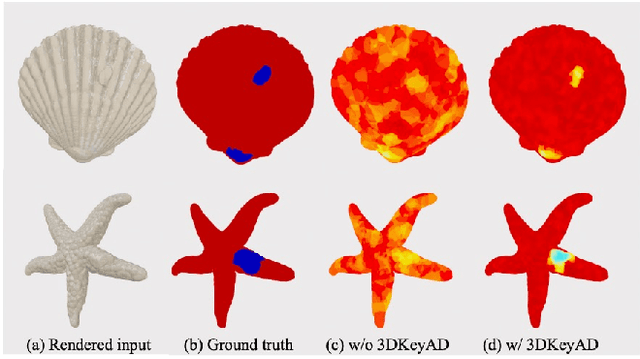
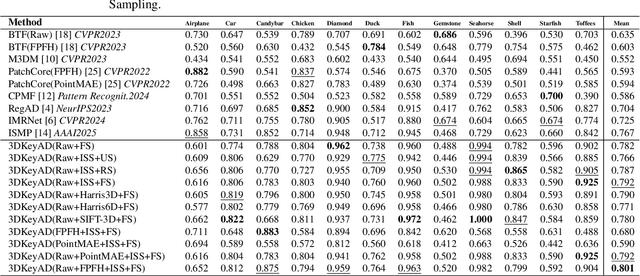
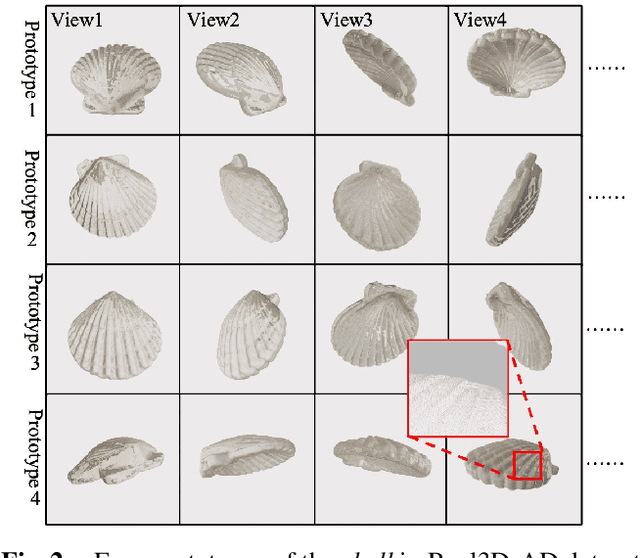
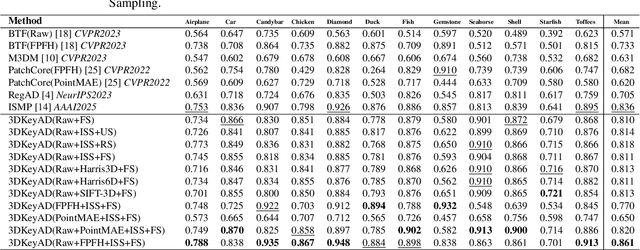
Abstract:High-resolution 3D point clouds are highly effective for detecting subtle structural anomalies in industrial inspection. However, their dense and irregular nature imposes significant challenges, including high computational cost, sensitivity to spatial misalignment, and difficulty in capturing localized structural differences. This paper introduces a registration-based anomaly detection framework that combines multi-prototype alignment with cluster-wise discrepancy analysis to enable precise 3D anomaly localization. Specifically, each test sample is first registered to multiple normal prototypes to enable direct structural comparison. To evaluate anomalies at a local level, clustering is performed over the point cloud, and similarity is computed between features from the test sample and the prototypes within each cluster. Rather than selecting cluster centroids randomly, a keypoint-guided strategy is employed, where geometrically informative points are chosen as centroids. This ensures that clusters are centered on feature-rich regions, enabling more meaningful and stable distance-based comparisons. Extensive experiments on the Real3D-AD benchmark demonstrate that the proposed method achieves state-of-the-art performance in both object-level and point-level anomaly detection, even using only raw features.
KaLM-Embedding-V2: Superior Training Techniques and Data Inspire A Versatile Embedding Model
Jun 26, 2025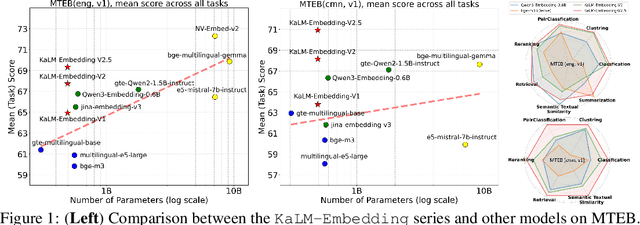



Abstract:In this paper, we propose KaLM-Embedding-V2, a versatile and compact embedding model, which achieves impressive performance in general-purpose text embedding tasks by leveraging superior training techniques and data. Our key innovations include: (1) To better align the architecture with representation learning, we remove the causal attention mask and adopt a fully bidirectional transformer with simple yet effective mean-pooling to produce fixed-length embeddings; (2) We employ a multi-stage training pipeline: (i) pre-training on large-scale weakly supervised open-source corpora; (ii) fine-tuning on high-quality retrieval and non-retrieval datasets; and (iii) model-soup parameter averaging for robust generalization. Besides, we introduce a focal-style reweighting mechanism that concentrates learning on difficult samples and an online hard-negative mixing strategy to continuously enrich hard negatives without expensive offline mining; (3) We collect over 20 categories of data for pre-training and 100 categories of data for fine-tuning, to boost both the performance and generalization of the embedding model. Extensive evaluations on the Massive Text Embedding Benchmark (MTEB) Chinese and English show that our model significantly outperforms others of comparable size, and competes with 3x, 14x, 18x, and 26x larger embedding models, setting a new standard for a versatile and compact embedding model with less than 1B parameters.
Text Embeddings Should Capture Implicit Semantics, Not Just Surface Meaning
Jun 10, 2025Abstract:This position paper argues that the text embedding research community should move beyond surface meaning and embrace implicit semantics as a central modeling goal. Text embedding models have become foundational in modern NLP, powering a wide range of applications and drawing increasing research attention. Yet, much of this progress remains narrowly focused on surface-level semantics. In contrast, linguistic theory emphasizes that meaning is often implicit, shaped by pragmatics, speaker intent, and sociocultural context. Current embedding models are typically trained on data that lacks such depth and evaluated on benchmarks that reward the capture of surface meaning. As a result, they struggle with tasks requiring interpretive reasoning, speaker stance, or social meaning. Our pilot study highlights this gap, showing that even state-of-the-art models perform only marginally better than simplistic baselines on implicit semantics tasks. To address this, we call for a paradigm shift: embedding research should prioritize more diverse and linguistically grounded training data, design benchmarks that evaluate deeper semantic understanding, and explicitly frame implicit meaning as a core modeling objective, better aligning embeddings with real-world language complexity.
PRISM: A Framework for Producing Interpretable Political Bias Embeddings with Political-Aware Cross-Encoder
May 30, 2025Abstract:Semantic Text Embedding is a fundamental NLP task that encodes textual content into vector representations, where proximity in the embedding space reflects semantic similarity. While existing embedding models excel at capturing general meaning, they often overlook ideological nuances, limiting their effectiveness in tasks that require an understanding of political bias. To address this gap, we introduce PRISM, the first framework designed to Produce inteRpretable polItical biaS eMbeddings. PRISM operates in two key stages: (1) Controversial Topic Bias Indicator Mining, which systematically extracts fine-grained political topics and their corresponding bias indicators from weakly labeled news data, and (2) Cross-Encoder Political Bias Embedding, which assigns structured bias scores to news articles based on their alignment with these indicators. This approach ensures that embeddings are explicitly tied to bias-revealing dimensions, enhancing both interpretability and predictive power. Through extensive experiments on two large-scale datasets, we demonstrate that PRISM outperforms state-of-the-art text embedding models in political bias classification while offering highly interpretable representations that facilitate diversified retrieval and ideological analysis. The source code is available at https://github.com/dukesun99/ACL-PRISM.
 Add to Chrome
Add to Chrome Add to Firefox
Add to Firefox Add to Edge
Add to Edge